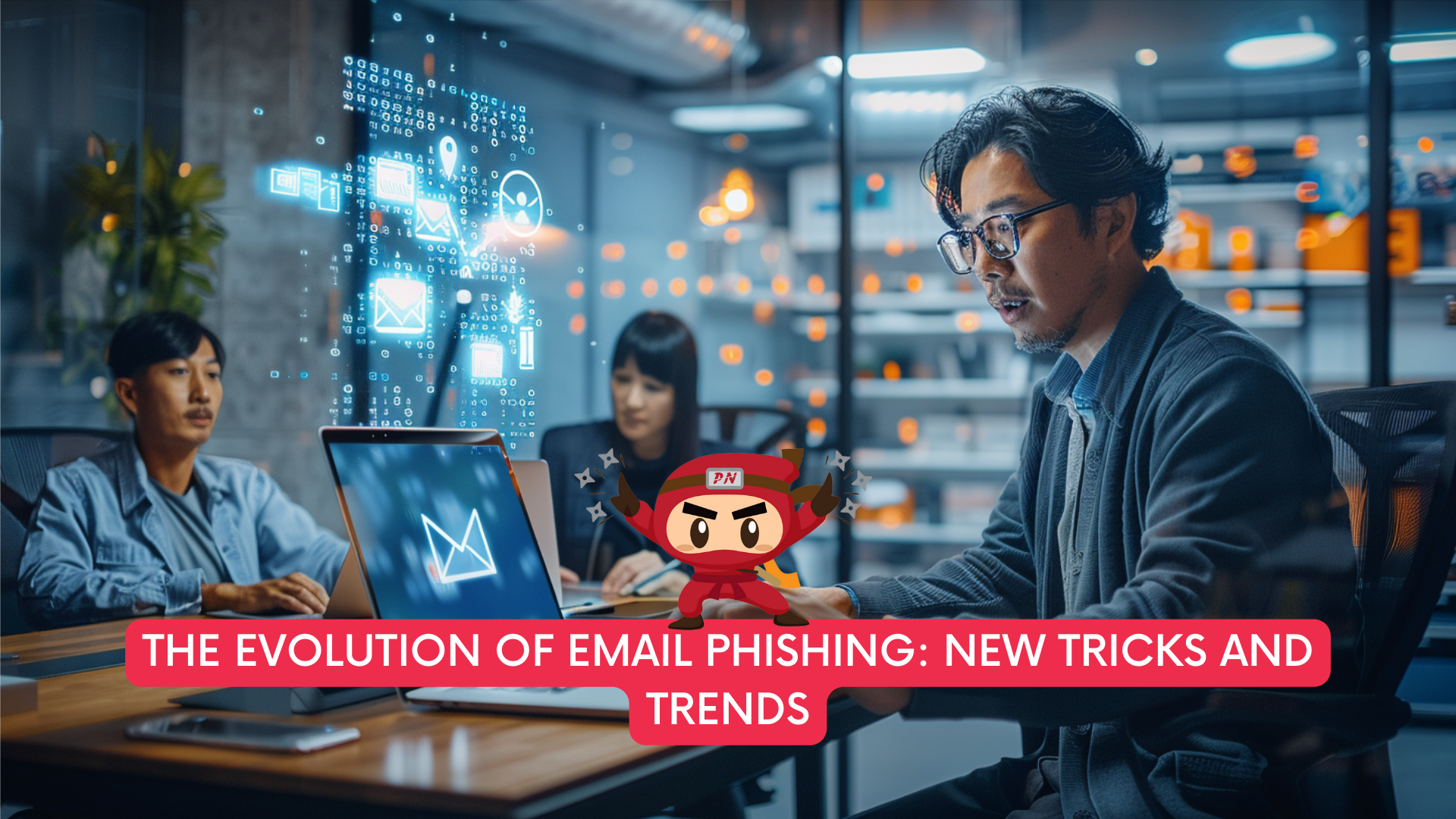KEEP IN TOUCH
Subscribe to our mailing list to get free tips on Data Protection and Cybersecurity updates weekly!







Email phishing, a persistent threat in the digital landscape, has evolved significantly over the years. Cybercriminals continually adapt their tactics to bypass security measures and deceive even the most vigilant users. Understanding the new tricks and trends in email phishing is essential for staying ahead of these ever-evolving threats. This article explores the evolution of email phishing and highlights the latest techniques and trends employed by cybercriminals.
In the early days of the internet, email phishing was relatively straightforward. Attackers sent out mass emails with simple messages, often rife with spelling and grammar errors, and awaited responses from unsuspecting victims. These early phishing attempts were easy to spot due to their crude execution.

As email users became more aware of phishing scams, cybercriminals refined their techniques, making their attacks more sophisticated and harder to detect. Here are some key developments in the evolution of email phishing:
Early Tactic: Generic, mass-distributed emails.
Evolution: Spear phishing targets specific individuals or organizations, using personalized information to appear more convincing. Attackers gather details from social media, company websites, and other sources to craft tailored messages.
How to Avoid: Be cautious of emails that include personal information and request sensitive data or unusual actions. Verify the authenticity of such emails by contacting the sender through a trusted method.
Early Tactic: Simple fake emails with obvious discrepancies.
Evolution: Clone phishing involves creating a nearly identical copy of a legitimate email that was previously sent. Attackers replace links or attachments with malicious versions.
How to Avoid: Always verify the source of an email, even if it appears to be a follow-up to a legitimate message. Look for any inconsistencies or signs of tampering.
Early Tactic: Basic impersonation emails.
Evolution: BEC targets high-profile individuals within an organization, such as executives, to request financial transactions or sensitive information. These emails often appear to come from trusted colleagues or partners.
How to Avoid: Implement verification protocols for financial transactions and sensitive information requests. Verify unusual or urgent requests through known contact information.

As technology advances, so do the tactics employed by cybercriminals. Here are some of the latest tricks in email phishing:
New Trick: Cybercriminals use AI and machine learning to automate and refine phishing attacks. These technologies help create more convincing emails by mimicking writing styles and generating personalized content.
How to Avoid: Stay updated on the latest phishing techniques and educate yourself and others about the potential use of AI in scams. Implement advanced email security solutions that utilize AI for threat detection.
New Trick: Deepfake technology, which creates realistic but fake audio and video content, is now being used in phishing attacks. Cybercriminals can create convincing videos or voice recordings that appear to be from trusted sources.
How to Avoid: Be cautious of unsolicited audio or video messages. Verify their authenticity by contacting the purported sender through a different communication channel.
New Trick: PhaaS platforms provide cybercriminals with ready-made phishing kits and services, lowering the barrier to entry for launching sophisticated phishing campaigns.
How to Avoid: Regularly update your security protocols and educate your team about the availability of PhaaS and its implications. Use comprehensive security solutions that can detect and block phishing attempts.
New Trick: Attackers leverage current events, industry trends, or recent company news to make their phishing emails more relevant and believable. For example, during the COVID-19 pandemic, there was a surge in phishing emails related to health updates and remote work.
How to Avoid: Stay informed about current phishing trends and scrutinize emails that reference recent events or industry-specific topics. Verify the information through reliable sources.
As cybercriminals continue to innovate, several emerging trends in email phishing have been identified:
Trend: Cybercriminals combine multiple phishing techniques in a single attack. For example, an email might use spear phishing tactics while also including a deepfake video to add credibility.
How to Avoid: Implement multi-layered security measures that can detect various types of threats. Educate users about the potential for hybrid attacks and encourage them to remain vigilant.
Trend: With the increasing use of mobile devices for email communication, phishing attacks targeting smartphones and tablets are on the rise. These attacks exploit the smaller screens and mobile-specific vulnerabilities.
How to Avoid: Use mobile security solutions and educate users about the risks of mobile phishing. Encourage them to scrutinize emails on mobile devices as carefully as they would on a desktop.
Trend: As more organizations move to cloud-based services, phishing attacks targeting these platforms are becoming more common. Attackers aim to compromise cloud accounts to access sensitive data.
How to Avoid: Implement strong security measures for cloud services, including two-factor authentication and regular security audits. Educate users about the risks and signs of cloud-based phishing attacks.
Trend: Phishing attacks increasingly incorporate social engineering techniques, manipulating victims into divulging information or performing actions that compromise security.
How to Avoid: Train users to recognize and resist social engineering tactics. Emphasize the importance of verifying requests and being cautious with unsolicited communications.
In addition to recognizing specific tactics and trends, adopting general best practices can help protect against phishing attacks:
If you suspect you have fallen victim to a phishing scam, it’s crucial to act quickly:
Email phishing continues to evolve, with cybercriminals employing new tricks and trends to deceive users. By staying informed about these developments and adopting robust security measures, you can protect yourself and your sensitive information. Vigilance, education, and the use of advanced security technologies are key to staying ahead of phishing threats and ensuring a safer digital environment for all.
One of the most common and damaging cyber threats today comes from email phishing attacks. With just one careless click, sensitive data can be exposed, operations disrupted, and under the PDPA, your organisation may even face financial penalties of up to S$1,000,000.
The best defence is preparation. That’s why Privacy Ninja’s Email Phishing Simulation service helps you test and train your staff against realistic phishing scenarios. By simulating actual attack methods, we uncover how susceptible your team may be to deceptive emails and provide actionable insights to strengthen your human firewall.
Our phishing simulations are tailored to your organisation’s needs, whether it’s imitating fake invoices, credential-harvesting emails, or spear-phishing attempts that closely mimic trusted senders. More than just a test, each campaign includes awareness training and detailed reporting so you can see exactly where your risks lie.
Beyond phishing, Privacy Ninja is also a licensed provider of penetration testing (VAPT) services as well as outsourced data protection officer as a service (DPOaaS), helping you detect vulnerabilities across your IT systems and networks. With years of proven experience in cybersecurity and a team of certified experts, we deliver results that are timely, thorough, and trusted by organisations across Singapore. And with our Price Beat Guarantee, you’ll never have to compromise between quality and affordability.
Don’t wait for a breach to happen. Start with an Email Phishing Simulation today and empower your employees to spot, resist, and report phishing attempts before they cause real damage.